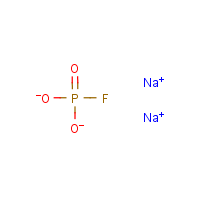Sodium monofluorophosphate (MFP)
On November 27, 2008, the European Food Safety Authority (EFSA) gave the green light to the use of Sodium Monofluorophosphate (and Calcium Fluoride) as a food supplement in Europe. According to the Alliance for Natural Health (UK): “Generally, when EFSA says a foodstuff is safe, it goes on free sale through all – now 27 – European Members States.”
See
• Comments to EFSA’s Opinion have been submitted by Dr. Vyvyan C. Howard.
• Commentary by The Alliance for Natural Health (ANH) on EFSA’s opinion (pdf).
• ANH’s Press Release calling for an inquiry into EFSA work after it cleared toothpaste toxin for use in food supplements.
EFSA’s Opinion:
Sodium monofluorophosphate as a source of fluoride added for nutritional purposes to food supplements[1]. Scientific Opinion of the Panel on Food Additives and Nutrient Sources added to Food. Adopted date: 27 November 2008. Question number: EFSA-Q-2006-277, EFSA-Q-2006-295
Summary
Following a request from the European Commission to the European Food Safety Authority (EFSA), the Scientific Panel on Food Additives and Nutrient Sources added to Food (ANS) was asked to provide a scientific opinion on the safety of sodium monofluorophosphate added for nutritional purposes as a source of fluoride in food supplements and on bioavailability of fluoride from this source.
The present opinion deals only with the safety of sodium monofluorophosphate as a source of fluoride and the bioavailability of the fluoride from this source. The safety of fluoride itself, in term of amounts that may be consumed, is outside the remit of this Panel.
Available literature on sodium monofluorophosphate and sodium fluoride suggests that sodium monofluorophosphate is hydrolysed in fluoride and phosphate ions and the Panel concludes that fluoride bioavailability will be to an extent comparable to the one from sodium fluoride. The most sensitive effect of fluoride exposure in humans is dental fluorosis and conclusions of comprehensive evaluations indicate that genotoxicity and carcinogenicity are not of concern for fluoride exposure in humans. Long-term clinical interventions trials have suggested that monofluorophosphate is better tolerated than other common sources of fluoride such as sodium fluoride. Based on toxicity data from readily soluble forms of fluoride tolerable upper intake levels (ULs) for fluoride have been established in Europe. The proposed supplementation foresees that sodium monofluorophosphate will be added to food supplements to supply between 0.25 and 2 mg fluoride per day, corresponding to approximately 2.5 to 16 mg sodium monofluorophosphate.
Daily sodium exposure estimates (1.7–14 mg) and phosphate (1.1–8.8 mg) arising from the proposed supplementations with sodium monofluorophosphate would be of no safety concern. Sodium exposure from this source represents at most only 0.3% of the estimated dietary intake of sodium in Europe (4500–11000 mg/day) whereas phosphate exposure would be at most approximately 460 times lower than the Maximum Tolerable Daily Intake (MTDI) of 70 mg/kg bw established for phosphates.
The ANS Panel concludes that the use of sodium monofluorophosphate as food supplement would be of no safety concern provided that fluoride tolerable upper intake levels established in Europe are not exceeded by the combined exposure from food supplements and the diet.
The ANS Panel noticed that most of these proposed levels of supplementation are below tolerable upper intake levels established for different populations in Europe. However, when the potential fluoride contribution of sodium monofluorophosphate supplementation is added to the total fluoride daily exposures estimates in Europe for children, in most cases fluoride tolerable upper intake levels will be exceeded. For adults, the proposed fluoride supplementation levels will not exceed the tolerable upper intake level with the exception of the supplementation value 2 mg/day.
The Panel notes that according to Commission Regulation (EC) No 629/2008 the maximum levels of respectively lead, mercury and cadmium in food supplements as sold should be respectively 3.0 mg/kg, 0.1 mg/kg and 1 mg/kg.
____________________________________
[1] For citation purposes: Scientific Opinion of the Panel on Food Additives and Nutrient Sources added to Food on a request from the Commission on disodium fluorophosphate added for nutritional purposes to food supplements. The EFSA Journal (2008) 886, 1-18.
Working Group that prepared the Opinion (same as for Calcium fluoride):
F. Aguilar
B. Bemrah
P. Galtier
J. Gilbert
S. Grilli
R. Guertler
G.E.N. Kass
C. Lambre
J-C. Larsen
J-C. Leblanc
A. Mortensen
I. Pratt
I. Stankovic
PANEL MEMBERS (same as for Calcium fluoride):
F. Aguilar
U.R. Charrondiere
B. Dusemund
P. Galtier
J. Gilbert
D.M. Gott
S. Grilli
R. Guertler
G.E.N. Kass
J. Koenig
C. Lambre
J-C. Larsen
J-C. Leblanc
A. Mortensen
D. Parent-Massin
I. Pratt
I. Rietzens
I. Stankovic
P. Tobback
T. Verguieva
R. Woutersen
NOTE: EFSA advises the member states of the EU:
Austria
Belgium
Bulgaria
Cyprus
Czech Republic
Denmark
Estonia
Finland
France
Germany
Greece
Hungary
Ireland
Italy
Latvia
Lithuania
Luxenbourg
Malta
Netherlands
Poland
Portugal
Romania
Slovakia
Spain
Sweden
United Kingdom

